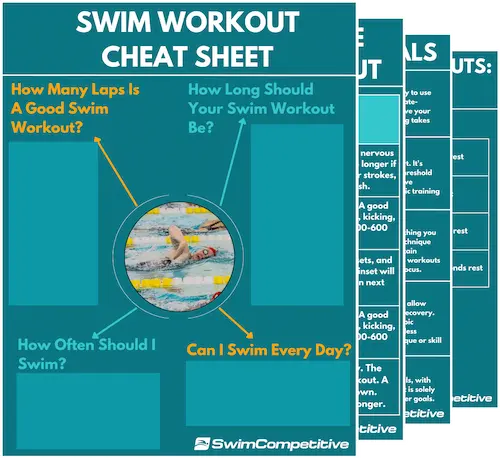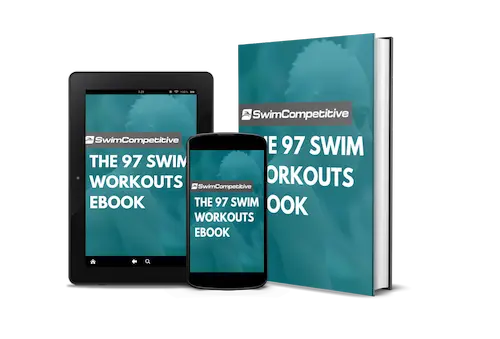Do you want to become a better and faster swimmer? Well, in that case, you should definitely consider adding some dryland exercises to your training routine.
It doesn’t have to be complicated, a couple of effective exercises at home can go a long way in helping you to reach new heights in your swimming career.
Adding dryland exercises to your schedule can have great benefits on your swimming times and can help you to swim much faster by strengthening important muscle groups, developing explosiveness, athleticism, and power.
Many elite swimmers, as well as Olympic and professional swimmers, use dryland- and weight training to supplement their swimming, so why shouldn’t you too?
With that said, let’s take a look at some great dryland exercises for swimmers at home, and after that, we’ll discuss some of the benefits as well as the science behind it.
10 Best Exercises For Swimmers At Home
Here are the best exercises for swimmers at home-
- Pull-ups
- Squats.
- Plank.
- Push-ups.
- Jump rope.
- Lunges.
- Sit-ups.
- Resistance band exercises.
- Box jumps.
- Russian twist.
1. Pull-Ups
Pull-ups are a great exercise for all swimmers. They develop the upper back muscles like the lats and traps extremely well. These muscles play an important role in the pulling motion of your stroke and can help you to generate a lot of speed and propulsion when swimming.
In fact, a study published by the Journal of Strength and Conditioning Research found correlations between pull-up strength and positive swimming performance.
There are many variations of the pull-up, and progression is quite simple. Beginners to the exercise can start out with resistance band-assisted pull-ups, while experienced swimmers can use a weighted variation to increase resistance and strength.
The pull-up can also be used to develop core strength by incorporating advanced variations of the exercise like L-Sit pull-ups and strict pull-ups with your legs extended slightly in front of you.
The majority of beginners, who have never trained pull-ups, will probably have a hard time doing this exercise. Luckily there are many progressions, and if you make sure to do them every day, you will quickly get stronger and better at them.
Of course, the pull-up exercise is going to require you to have a pull-up bar. Personally, I believe this is something every swimmer should have anyway. If you don’t have a pull-up bar, consider checking out this cool wall-mounted one:
or alternatively, check out this simple doorway pull-up bar:
All in all a great exercise that swimmers can do at home and easily one of the best too. If you’d like to learn a bit more about why this exercise is so great for swimmers and some more variations, then I recommend checking out my article- why every swimmer should do pull-ups.
2. Squats
Squats are probably one of the best exercises for overall leg strength and development out there. They target all the of the major muscle groups in your legs, including the quadriceps, hamstrings, calves, and glutes.
Bodyweight squats are relatively easy to perform and don’t require much technique. They can help you build both strength and explosive power in your legs, which will help you to kick faster, have better starts, turns, and underwaters- all of which can make a massive difference in your swimming speed.
Just for some perspective, a study published by the BioMed Research Journal found evidence that the kick can generate up to 29.7% of speed for male swimmers and 33.4% for female swimmers when swimming freestyle. Other strokes like breaststroke and butterfly may gain even more speed from the legs.
There are many different variations of the squat that you can perform. Some examples include jumping squats and barbell back squats, split squats, and goblet squats. That said, if you do decide to add weights to your squats, you have to make sure your technique is perfect. Otherwise, you can injure yourself.
But seeing as we are talking about exercises that swimmers can do at home, I am going to recommend standard squats, jumping squats, and if you are a little stronger, you can add a medicine ball or some dumbbells to your squats for extra resistance.
3. Planking
As we all know, core strength is very important in swimming, and the plank is one of the best exercises to develop overall core strength. The core plays many roles in swimming, like helping to link the upper and lower body for increased power exertion, enhancing stability in the water, improving body position, and allowing for fast underwaters.
Many swimmers lack good core strength and, as a result, are putting themselves at a huge disadvantage.
Planking technique is very simple and easy to master, and the exercise can be performed virtually anywhere. There are also many different variations of the plank, so make sure to play around with them. Some examples include weighted planks and ab-wheel rollouts, which are just a more dynamic variation.
Gradually increase the number of seconds you perform the plank over time or use some of the more advanced variations in order to keep getting stronger.
4. Push-Ups
Push-ups are a great overall upper-body strength exercise. They mainly target the chest, triceps, and shoulders muscles. These muscles all play a critical role in swimming by developing a stronger pull that will help you to increase your speed and propulsion in the water.
Many swimmers lack good strength in their chest and triceps, and the push-up is a great way to build some strength in these areas.
Furthermore, there are many different variations of push-ups. Start with a basic push-up and play around with some of the more advanced versions as you get stronger. A few examples include- weighted push-ups, clap push-ups, superman push-ups, decline push-ups, and so on.
If you do think weighted push-ups may be right for you, consider checking out this weighted vest on Amazon:
Also, make sure to gradually increase the reps and sets as you get stronger in order to ensure progress in this exercise.
Do You Want to Make Every Lap Count?
Stop wasting your time in the pool feeling lost and doing directionless swim workouts, and start training effectively! Our ebook contains 97 structured and goal-orientated swim workouts to help you become a better, faster, and fitter swimmer. Whether you’re a complete beginner or a seasoned pro, there are a multitude of workouts for every type of swimmer.
5. Jump rope
Jump rope, also known as skipping, is a great way to develop agility and speed outside of the water. It doesn’t require much space and can easily be performed at home. Jump rope will also help to strengthen your calve muscles which are required for starts, push-offs, and kicking. Further, it’s also a great way to train your aerobic system and develop some extra endurance.
Many elite swimmers use jump rope as part of their training routine. Technique is quite basic to learn, but actually getting good at jump rope can take some time and practice to find a good rhythm. As you get better, you can also experiment with more advanced variations like the boxers jump or double unders.
If you don’t have a jump rope, you can check out this one on Amazon:
6. Lunges
Lunges are another great exercise to incorporate into your dryland training for leg strength and development. This exercise requires minimal space and can be performed in your room or backyard quite easily.
Like many of the exercises, there are also a couple variations to try out. Some include walking lunges, jumping lunges, reverse lunges, and so on. As you progress with this exercise, you can also increase the resistance by adding things like dumbbells or a weighted vest to become stronger.
For most swimmers, however, I just recommend the jumping lunge as this will quickly get your heart rate up and develop some explosive power and athleticism that can help you to swim faster. The other variations are also good, and I recommend that you play around and find what you like.
7. Sit-Ups
Sit-ups are probably one of the most basic and simple core exercises out there. Yet it is still highly effective and a great way to build some additional core strength. Although less superior to the plank, since it doesn’t work the entire core, it is still a good exercise and can easily be performed at home.
Getting in a lot of sit-ups can be a time-effective way to strengthen your core without any complicated technique or equipment required. Personally, I like to dish out a 100 to 200 reps of these after my swim workout just to get in some extra core work every day.
If you want to check out some more great core exercises for swimmers, then I recommend reading my article on the 10 best core exercises for swimmers at home.
8. Resistance band exercises
Although not a specific exercise, there is a ton of potential here to develop strength and power in both your upper and lower body. The number of resistance band exercises out there is endless, and what’s more, is you can actually mimic your swimming strokes to train them on land with more resistance to develop strength and power in the water.
For the most part, resistance band exercises don’t require much space and can very easily be performed in your home or backyard.
Some of my favorite resistance band exercises include- chest press, tricep extensions, overhead presses, squats, and back rows. If you’d like to get an extensive list of some good strength resistance band exercises, consider my article on the best resistance band exercises for swimmers.
If you don’t have a resistance cord, consider checking out some of these swim-specific ones by FINIS on SwimOutlet by clicking here. They are super high quality and designed specifically for swimmers to become stronger and faster in the water.
9. Box Jumps
If you want to be explosive in the water and have good and powerful starts, turns, and underwaters, then you better incorporate the box jump into your training routine. The box jump is easily one of my favorite exercises for developing explosive power, and it also strengthens all of the major muscle groups in your legs.
The box jump can easily be performed at home, all you require is a plyometric training box, or alternatively, you can use a bench or step (just make sure that you won’t fall). Progression can be achieved by jumping higher as your jumping capabilities improve, or you can perform additional reps.
If you don’t have a plyometric training box and want to consider adding one to your home gym equipment, consider checking out this one on Amazon:
10. Russian Twist
Lastly, we have the Russian twist exercise. The Russian twist is another great core exercise, although more advanced and harder than sit-ups.
This core exercise will strengthen the majority of your abdominal muscles but is especially great for freestyle and backstroke swimmers.
The reason for this is that it simulates the rotating movement performed in these strokes. That, however, doesn’t mean that other swimmers shouldn’t still use it in their training routine. This exercise is great for strengthening the obliques, a muscle not often trained by other core exercises, and will also help to develop some stability in the water.
It also doesn’t require a lot of space to perform and can easily be done at home as part of your dryland training routine.
5 Benefits of dry-land Training for Swimmers
1. Improved power and speed
There is only so much power that can be built in the pool. When you add dry-land to your training schedule, it can seriously improve your swimming performance and speed inside of the water.
Exercises on land help a lot to develop explosive power in the water. This explosiveness can be applied to starts, turns, dives, and finishes. This extra baseline of strength will also help you to pull and push water with more power and thus swim faster to beat your opponents and smash some PBs.
In fact, a study published by the Journal Of Sports Science and Medicine actually found evidence that a combined dryland and aerobic training program showed tendencies to improve swimming performance due to increased strength on land.
2. Increased core strength
Core strength is one of the most important factors in swimming. It ensures increased power exertion and keeps you stable in the water.
Not just that, this connection will assist in many aspects of a race- like a strong underwater dolphin kick for example.
The core also plays a huge role in maintaining a correct body position, ensuring minimized drag in the water. Furthermore, a strong core will enable a swimmer to accelerate faster after dives and turns by linking the upper and lower body to work together more efficiently.
3. Injury prevention
From personal experience, I have experienced some of the injuries caused by swimming myself. I know many of you have, too, because, to be fair, in a sport that is extremely physically demanding, they aren’t quite all that uncommon.
The repetitive motions carried out over and over in the water can easily lead to injuries.
Dryland can assist in developing areas largely undeveloped by swimming. Like the lower back, for example. Swimming tends to use most of the muscles in your body, but some much more than others.
This leads to those muscle groups easily getting overdeveloped compared to your other muscle groups. These imbalances can cause uncomfortable injuries. Not to worry, if you do your dry-land training correctly, the chances of this happening are much slimmer.
Having stronger muscle groups will also prevent injury by distributing force correctly, allowing for less stress on joints and tendons.
4. Increased muscle mass
Swimming alone isn’t great at building muscle. The reason is that the body adapts to the resistance of the water very quickly. In swimming, it is very hard to increase resistance in every training session.
Yes, as you progress and get stronger as a swimmer, more stress will be applied to your muscles, but the rate at which it increases is usually too slow to build significant muscle mass.
Not just that, but the resistance of the water alone isn’t enough to make large muscle gains. This is the reason most swimmers tend to be more on the skinny side.
When you look at many professional swimmers, however, you will quickly notice that many of them are usually quite built.
I can guarantee most of this muscle is built outside of the water when doing dry-land training. The extra muscle mass allows for more surface area to pull and push water with and will make you faster. Not just that, it can greatly increase the amount of power you are able to exert in a short amount of time. (Typically, the reason why sprinters are the strongest swimmers).
5. Improved biomechanics
Dryland exercises can assist in better posture, muscle coordination, and recruitment. This can improve technique in the water and will also assist in balance and stability while swimming.
To improve biomechanics, you usually want to focus on exercises that strengthen large muscle groups as well as training more than one muscle group at a time. These exercises are known as compound exercises and are great for developing strength, power, and athleticism.
Luckily for you, all of the exercises in this article are compound exercises, and you are good to go!
Become a Better Swimmer At Home With These Dryland Exercises
Dryland exercises are very important for swimmers. It will help you to get stronger outside of the water, which in return will make you faster and more efficient inside of it.
I recommend that you do 5 or 6 of these exercises 2 to 3 times a week. Perform three sets of 8-12 reps per exercise (you can do more if you are strong enough), and make sure to include a variety of exercises that train both the upper and lower body.










